Here are this month's Wirral's Wild 50 activity sheets. In December, make your own bird feeder and learn how to identify trees in winter by looking at their twigs.
Here are this month's Wirral's Wild 50 activity sheets. In December, make your own bird feeder and learn how to identify trees in winter by looking at their twigs.
 |
| Alison McGovern MP planting a tree |
Tree
Planting to celebrate Wirral Wildlife’s 50th Birthday
Wirral Wildlife were delighted to celebrate their 50th Anniversary on a fine autumnal day on 20th November at Brotherton Park, part of Dibbinsdale Local Nature Reserve. The High Sheriff of Merseyside, Nigel Lanceley, and Alison McGovern MP kindly attended our celebration.
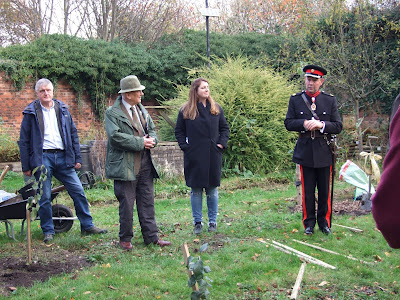 |
| The High Sheriff of Merseyside, Nigel Lanceley, gives a speech. |
We were heartened by the presence of the Chairman and Vice Chairman of Cheshire Wildlife Trust, so many friends from related organisations and long serving volunteers spanning all the activities in which we engage. The chairman outlined the history of the group and gave thanks for the efforts made by the founders and all current supporters. The High Sheriff stressed how prestigious is the award of the QAVS. The key issue being the way we engage with disadvantaged groups in an inclusive way and seek to assist the cause of wildlife generally.
A female black poplar was planted by the High Sheriff in Brotherton Park. It was he who had processed our nomination for the QAVS, so it was a particular pleasure that he was able to attend. Thereafter we planted six varieties of Cheshire apple trees in the Walled Garden (see details below).
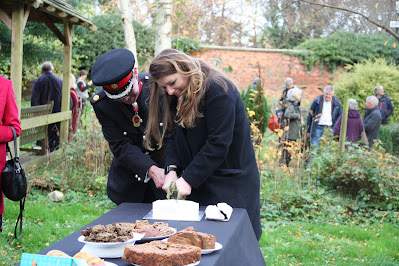 |
| Cutting the cake with a billhook! |
Then the High Sheriff and Alison McGovern MP cut the anniversary cake with a polished bill hook, before distributing slices on the end of his sword. Tea and cake were enjoyed by all our guests.
 |
| Handing out slices of cake on the end of the High Sheriff's sword. |
Thank you to everyone who attended to make the occasion such a special celebration.
This is a list of the trees we planted and who helped:
1. Bramley. Cooker. (Donated by Friends of Dibbinsdale to mark Wirral Wildlife’s 50th birthday). Supplied by Morrey’s Nursery, Kelsall.
The Friends told us “Happy Birthday to Wirral Wildlife. We look forward to continue working cooperatively with you in future years”.
Planted by Alison McGovern MP, Stephen Ross (Chair of Wirral Wildlife), with help from Steve Yandell (chair, Wirral Countryside Volunteers) and Tim Gannicliffe (WW recorder).
2. Millicent Barnes. Dessert.
Planted by Bella Smallthwaite helped by Ron Warne (Friends of Dibbinsdale and recorder) and Paul Loughnane (reserves manager, NFBP and Thornton Wood).
3. Eccleston Pippin. Dual purpose.
Planted by representatives of the Wirral Wildlife recording team: Mike Inger, Sheila Ross, Elina Doss (who also works for Record local records centre).
4. Rival. Dessert.
Planted by David Parker (DECG), Tom McCullough (warden Foxes Wood and Tom’s Paddock) and Steve Lyus (chair, New Ferry Butterfly Park).
5. Bee Bench. Dual purpose.
Planted by young volunteers Mairead Corr and Maddy Green, helped by Pete Miller (chair, Friends of Dibbinsdale).
6. Ashmead’s Kernel. Dessert.
Planted by Elaine Mills in memory of Frank Cottrell (former chairman), helped by Lesley Brockbank (Wirral & Cheshire Badger Group) and Eric Greenwood (retired from Liverpool World Museum and botanical expert).
Trees 2-6 were raised and supplied by Katie Tonge (Heathfield Orchard, Chester). All are varieties traditionally grown in Cheshire.
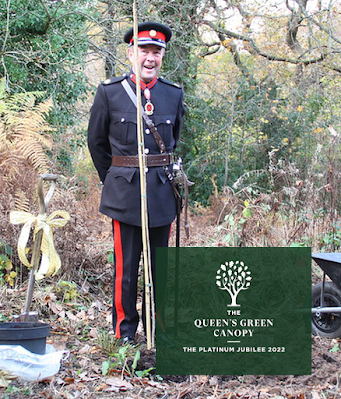 |
| The High Sheriff of Merseyside with the planted black poplar, a contribution to the Queen's Green Canopy project. |
Dr Hilary Ash registered our black poplar and apples as a contribution to the Queen’s Green Canopy project (QGC). This is a tree planting initiative created to mark Her Majesty’s Platinum Jubilee in 2022 which invites people from across the United Kingdom to “Plant a Tree for the Jubilee”.
We received this acknowledgement.
“We are delighted to confirm your Jubilee tree planting has been uploaded to The Queen’s Green Canopy (QGC) map. Thank you for your contribution to this special initiative, which we hope will inspire countless others. With your support we are creating a greener UK and a legacy in honour of The Queen’s leadership of the nation, which will benefit future generations.
Yours sincerely, The Queen’s Green Canopy”
The High Sheriff also wrote to us.
‘’ I would like to thank you all for the warm welcome and hospitality on Saturday. I was honoured to plant the tree and contribute to the ceremony. I would like to congratulate you again for all the great work that you carry out in Wirral. As residents we all benefit from your commitment. Please pass on my regards and best wishes to the team and if I can help again please do not hesitate to contact me. I think it is a great compliment to the group that you have reached the ripe old age of fifty. This means that you are still very important in our communities and as I said you are vital for the next 50 years.
Thank you again and best wishes,
Nigel’’
There is an album of photographs of the event taken by Richard Ash:
https://www.flickr.com/photos/30661871@N03/albums/72157720161168189
 |
| The Unilever team ready for action at the Butterfly Park |
The Butterfly Park was fortunate to host a corporate event for Unilever’s laundry team who cover packaging!
They all had a great day gardening, repairing a bench, removing water lily from the pond, hedge laying, re-exposing old railway track beds on the lime, bagging up wood chip, removing two-flowered honeysuckle and having a tour of the park.
 |
| Fixing the Silver Jubilee bench |
Some of the volunteers went to Screwfix for a few bits and pieces to restore the Wirral Countryside Volunteers’ Silver Jubilee (2010) bench. Whilst doing this a smooth newt was found which Boa thought was dead, but it was just acting dead! We placed the newt elsewhere and it soon made a dart for it. When someone went in the pond with chest waders on to lift out the large water lily his co-workers were around with the camera to catch the moment if he fell in. He did not oblige and the water lily was successfully removed. Four builders’ bags of the two-flowered honey suckle were removed, the most ever removed in a single session. The lime siding was cleared re-exposing some of the railway heritage which underlies the park.
 |
| Removing water lily from the pond |
 |
| Wading into the pond to remove water lily (and trying not to fall into the water!) |
The weather was great, tea and homemade cakes were available and for lunch there was a selection of pizzas.
We hope their muscles were not too tired the following day. There was a good team collaboration, some of whom had just recently joined the group and others whom were working from home so we hope it was a good team building exercise too. It certainly helped the park move forward with projects we do not often get around to. Some participants were interested in helping out at our monthly work parties and the profile of the park has been raised. Our new gates arrived on the same day, so it was a real hive of activity at the park.
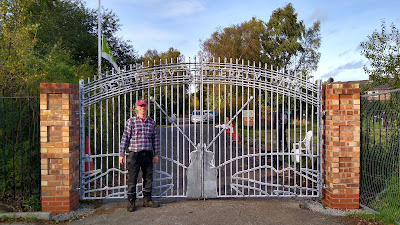 |
| The new gates at New Ferry Butterfly Park |
At New Ferry Butterfly Park the brick pillars have been raised, filled with concrete and left to set for five weeks, and now the new Silver Jubilee Gates are installed. Take a walk or train ride to have a look. Painting of the galvanised gates will be undertaken by Carol Ramsay, who has been Artist in Residence at New Ferry Butterfly Park.
 |
| Installation of the Silver Jubilee gates at New Ferry Butterfly Park |
It was Carol who inspired the Park’s committee to get involved in artworks. She organised the first Open Day in 2010, which pre-Covid became an annual event attracting 900-1000 visitors. From 2010, our artworks have developed over the years and are very much part of the character of the park. There is a certain pleasing symmetry of Carol being involved in the gates. Pam Sullivan, another artist with a longstanding association with the Park, will be producing six unique decorative tiles for the gate pillars, which reflect what can be found in the Park. There will be a grand opening of the gates on 1st May 2022 at 11am. The Park’s art leaflet will need updating, as the gates are the most ambitious and durable art work installed to date!
 |
| The back of the Silver Jubilee gates at New Ferry Butterfly Park |
During the period of the gate construction some temporary gates were installed which were not as secure, resulting in the Park suffering some vandalism. Damage was done to the Imago Hut, which is now being repaired. It just shows you why secure gates are required. We were alerted to intruders on three occasions by local residents and Merseyrail Security, so when the intruders entered and the park’s volunteers arrived 10 minutes later, the culprits knew we were on to them and were soon dissuaded from intruding again. Many thanks to our neighbours for alerting us to these evening visitors. The new gates are more secure as well as being aesthetically pleasing.
 |
| The Silver Jubilee gates at New Ferry Butterfly Park, with Green Flag behind at half mast in tribute to Frank Cottrell |
Frank Cottrell recently donated £1,000 toward the Silver Jubilee Gates. That generous donation is similar to what is raised on a bustling Open Day, or from the Crowdfunder appeal to raise funds for the gates. In 1993, Frank was instrumental in getting the Cheshire Wildlife Trust to underwrite the lease of “Alma Street Goods Yard” as the Butterfly Park was known then. As Chair of Wirral Wildlife, he went over the heads of Cheshire Wildlife Trust staff and got the Cheshire Wildlife Trustees on board. At the time, urban nature conservation was a new direction for the Trust. Frank retired as a Butterfly Park warden in 2017, when he was 94. Frank took delight in how the park has progressed over the years and how it has engaged large numbers of people with wildlife. Thank you Frank. The Green Flag at the Butterfly Park is flying at half-mast in respect for Frank, who died recently (see tribute to Frank Cottrell).
Here is the second worksheet for Wirral's Wild 50. For November we have a hedgehog theme. As well as finding out how you can help hedgehogs, why not try making an insect house or bug hotel.
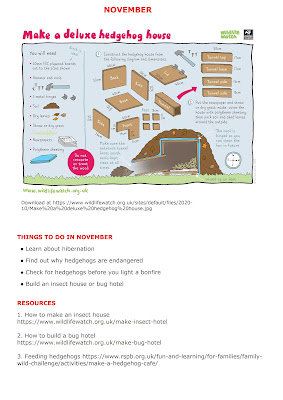 |
| Make a deluxe hedgehog house and other things to do in November |
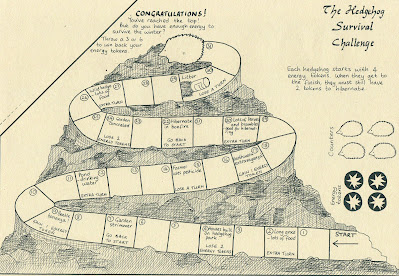 |
| Play the Hedgehog Survival Challenge |
 |
| Frank Cottrell in 2020, with a painting by Mel Roberts of a white tailed eagle |
It is with great sadness that we report the recent death of Frank Cottrell who would have been 99 in November.
Frank was the Chairman of Wirral Wildlife from 1989 to 1998 and a Trustee of Cheshire Wildlife Trust from May 1992 to June 2005.
It was Frank who lobbied Cheshire Wildlife Trust to let us use the name `Wirral Wildlife’. He recognised that, with Wirral not having been part of Cheshire since 1974, the `Cheshire’ name made no sense to much of our population. We are still very grateful for that. Frank was ahead of the game in putting the name wildlife in the group’s title, well before Cheshire Conservation Trust changed its name to Cheshire Wildlife Trust in 1991, as it was not clear in the name what we were conserving,
Frank took a great interest in the planning and development role of Wirral Wildlife and signed our letters to planning authorities when chairman. He and his neighbours campaigned to keep the large oak tree on Dibbins Hey when the Poulton Lancelyn estate was built, getting it incorporated in a roundabout. It is still standing and a favourite tree with local residents for birthday photographs and other family events.
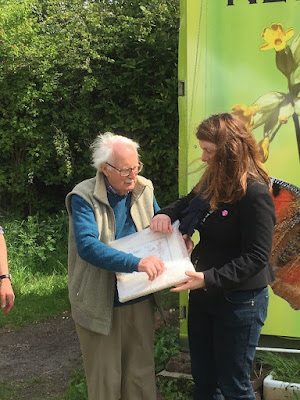 |
| Alison McGovern MP presenting Frank with his retirement present after he stepped down as a warden of New Ferry Butterfly Park at the age of 94. |
In 1993 he was instrumental in persuading Cheshire Wildlife Trust to take on New Ferry Butterfly Park as a nature reserve. He volunteered there as a warden on Sunday afternoons and only retired when he was 94, encouraging others to volunteer too ‘because it was such fun’. Recently he made a generous donation to help fund new, decorative gates for the Park. The Green Flag at the Park has been flying at half mast in tribute to him.
 |
| The Green Flag at New Ferry Butterfly Park flying at half mast in tribute to Frank Cottrell |
The Butterfly Park wasn’t Frank’s only achievement. He and his friend Eric Warner created a game called Frog Dip consisting of a plastic pond and a dozen plastic frogs. This was taken to fund raising events and for a small charge children could pick a frog out of the water and win a prize. We were still using this until Covid struck - although the frogs are probably well past retirement age by now.
 |
| Frank with an apple pie made by the Country Mouse at one of our Apple Days |
For several years Frank organised our annual Apple Day at Brimstage Hall every October. He managed to persuade the owner of the Country Mouse restaurant to bake a lovely apple pie for us each year. Some of us didn’t have the same success in later years! The orchard at Brimstage was of great interest to him, especially the damsons which he enjoyed stewed at breakfast time! When the trees in the orchard were in need of some care and attention, before the Tree Wardens took over, he and Elaine Mills helped to identify the trees and do some pruning.
Frank never stopped noticing the wildlife around him. A few years ago he and Elaine spotted Henbane at Burton Marshes. Henbane had been recorded at Burton but Frank and Elaine rediscovered it after many years absence. He was always alert to sightings in his own garden and I remember the photograph of the Hummingbird Hawk-moth he sent us for the Wirral Wildlife Blog. The last time I spoke to him he told me he could see a red legged partridge outside his window.
 |
| Hummingbird hawk moth. Photo taken by Frank in his garden. |
Words to describe Frank? Supportive, knowledgeable, possessed of a wry humour and a sense of fun.
In the words of Stephen, our current Chairman, Frank was ‘a delightful character who remained interested in all that we did until the end. The happy times we spent in his company will remain in the memories of all who knew him’.
Frank had a long life and has left a lasting legacy through his hands-on involvement with Wirral Wildlife. We thank him and will miss him.
Here is the first of our set of worksheets to celebrate Wirral's Wild 50! In October, you will start to see nuts and berries on trees and shrubs. See if you can tick off all the species pictured on the worksheet below.
 |
| Find nuts and berries and other things to do in October |
Other things to do in October:
● Learn about fungi
What are fungi?
Why are they important?
Fungi in the woods
https://www.britmycolsoc.org.uk/application/files/7214/9752/5133/Fungi_in_the_woods.pdf
Identify fungi
https://www.britmycolsoc.org.uk/application/files/7515/8921/1532/Fungus_Detectives_final.pdf
● Try growing an acorn
● Make a twig tower
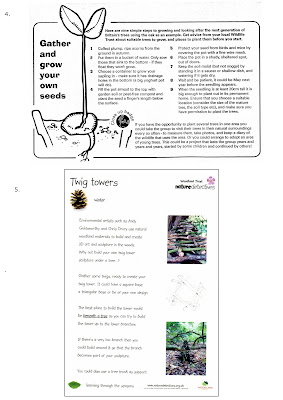 |
| Gather and grow your own acorn and make twig towers |
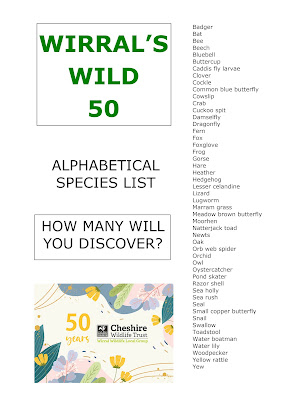 |
| Wirral's Wild 50. How many will you discover? |
This year it is the 50th anniversary of the creation of Wirral Wildlife as the local group of Cheshire Wildlife Trust.
To mark the occasion we decided to create a monthly educational resource for local schools and called it ‘Wirral’s Wild 50’. We provided a list of 50 species of plants and animals to be found on the Wirral and their habitats. Each month there is a worksheet of things to do, a list of online resources and a relevant activity, game or craft.
This month we are giving you the species list – how many will you be able to find?
 |
| 5 habitats found on the Wirral and some of the species you will find there |
Then each month we will post the sheet on our Blog to reach a wider audience. Please do let us know if you find it useful.
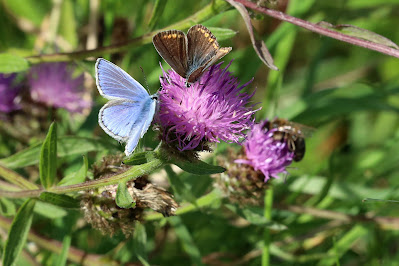 |
| Male and female common blue butterflies (Polyommatus icarus) |
In August, New Ferry Butterfly Park had 13 visitors from the Tanyptera Trust and Liverpool World Museum, who had organised an invertebrate recording day. This included experts on beetles, hoverflies, parasitic wasps, spiders and a whole range of other 'mini-beasts'.
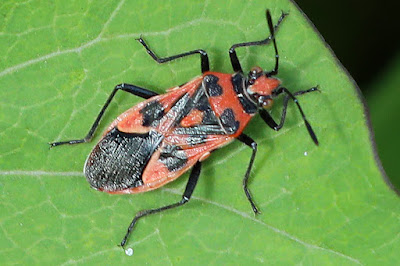 |
| Cinnamon Bug (Corizus hyoscyami) |
The sun shone and it stayed dry, and much collecting was done, including in places the rest of us might think unlikely, such as the compost bins and the woodchip pile. The full results will not be known for a while, as identifying these creatures can be difficult, but Roy Lowry has kindly let us show you some of his pictures.
 |
| Meadow grasshopper (Chorthippus parallelus) |
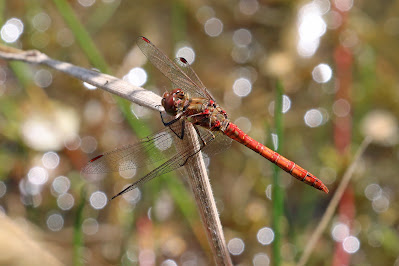 |
| Common Darter Dragonfly (Sympetrum striolatum) |
 |
| Buff tailed bumblebee (Bombus terrestris) |
 |
| Long hoverfly (Sphaerophoria Scripta) |
 |
| Crab spider (Xysticus cristatus) |
 |
| Honeybee (Apis mellifera) and a wasp Glypta vulnerator |
 |
| The cleared land in Hoylake in February 2020 |
 |
| Teasels and sunflowers |
 |
| Chives and yarrow |
Wirral Wildlife is a branch of the Cheshire Wildlife Trust, one of the network of 47 local Wildlife Trusts protecting wildlife across the UK.
Wirral Wildlife manages local nature reserves, keeps records of wildlife, scrutinises planning applications and runs a programme of meetings and guided walks open to the public.
Our website: www.wirralwildlife.org.uk
and events guide: www.wirralwildlife.org.uk/events.html